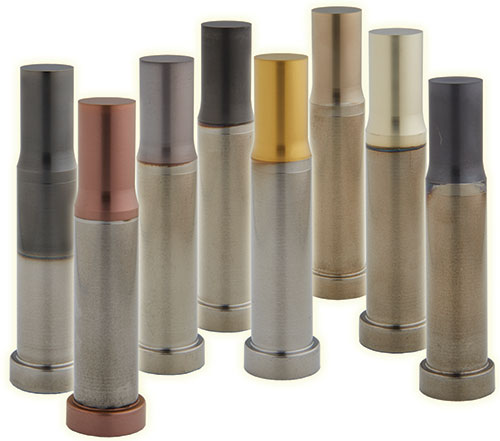 Jeremy Edson
Jeremy EdsonConfused About Tool Coatings? These Tips Will Help
January 1, 2017Comments
Key areas abound where manufacturers can identify stamping challenges and narrow coating options to avoid a lack of success or, worse, even more problems.
 Stamping operations often can leave fabricators perplexed and frustrated with tooling failures and the quality of finished parts. Galling, microfractures, chipping, breakage and numerous other challenges lead to costly downtime, unnecessary tool wear and added costs for frequent tool sharpening or remanufacturing.
Stamping operations often can leave fabricators perplexed and frustrated with tooling failures and the quality of finished parts. Galling, microfractures, chipping, breakage and numerous other challenges lead to costly downtime, unnecessary tool wear and added costs for frequent tool sharpening or remanufacturing.
When the problem isn’t obvious, and continued troubleshooting leads to even more confounding results, combining the right coating for the particular application and material can make the difference.
Incorporating coatings can help manufacturers in a number of ways, by:
- Eliminating secondary operations
- Producing higher-quality parts
- Increasing tool life
- Increasing tool-edge life
- Adding lubricity
- Minimizing adhesion.
Determining the ideal combination of coating, application and material can be a lesson in trial and error. There are key areas, however, where metalformers can identify stamping challenges and narrow the options to avoid a lack of success or, worse, even more problems.
Assess the Application
A simple task that often yields complex information, assessing the application and identifying potential pitfalls and challenge areas are the first steps in identifying the coating and tool-steel combination that will work best.Piercing, blanking, trimming, forming, high-pressure forming, high-heat applications, high-impact applications—all of these present unique sets of challenges when selecting the right tool coating. A basic coating will garner results and add longer life to the tool, no matter the type of application.
When a basic coating fails to provide sufficient results, however, metalformers can move to a harder coating. For piercing, blanking and forming applications in particular, coatings with a hardness of 2900 to 4000 HV are ideal. The coefficient of friction for these coatings should be between 0.3 and 0.6 for maximum results.
Tool coatings for these types of applications include proprietary coatings available from tooling manufacturers, as well as TiCrN and TiZrN. While all of these coatings result in increased wear resistance, improved surface finish and added toughness, many proprietary options and TiCrN are particularly helpful in reducing galling.
Many stamping operations involve high-impact, high-heat or high-pressure applications, all of which create significant stress on the tooling. For high-impact applications, AlCrN is the ideal choice except when working with aluminum materials. When working in high-heat applications, TiAlN and AlTiN give metalformers exceptionally hard coatings that perform best when working with stainless, high-strength or ultra-high strength steel. As an added benefit of stamping at high surface temperatures, aluminum oxide forms on the tool, which enhances coating performance. Here again, stamping aluminum with these coatings is not recommended.
Some proprietary coating options from tooling manufacturers are specially designed for high-pressure applications as well as for punching and forming high-strength low-alloy (HSLA) steels. Such coatings deliver full surface quality on polished steels, reduced galling and longer punch wear.
Take Measure of the Material
Different part-design requirements dictate the type of workpiece material—and each type of material comes with its own unique set of challenges. As such, different coatings have a vast array of effects when used for stamping specific materials, and identifying the best coatings for particular materials at the onset of production can help prevent challenges and frustrations down the road.
Many proprietary coating options are designed for aluminum and other soft materials, such as mild and galvanized steel, while other coating options for producing aluminum parts ideally are suited for use on materials prone to galling. Additional tool-coating choices when working with aluminum include TiZrN, which is adept at helping create parts made of other nonferrous materials, such as copper and brass. Coatings that do not enhance production when working with aluminum include AlCrN, TiAlN and AlTiN.
Stainless, high-strength and ultra-high strength steels normally experience the best results using TiAlN and AlTiN coatings, especially in high-heat applications. When using these types of coatings, an aluminum oxide forms, which helps enhance performance. For HSLA steels, proprietary multilayer nanocoatings perform well under high-pressure applications for punching and forming.
Pick the Proper Tool Steel
The last piece of the puzzle is determining the best tool steel for the job. When considering the application, materials, tool steel and the advantages and limitations of each, adding the coating is like the icing on the cake. It’s the added benefit that allows the tool to outperform and out-produce an uncoated tool in a similar setup.
M2 tool steels provide good results for virtually any type of part material. Best used in cases of high-compression, M2 delivers wear resistance and toughness in essentially any application. If the job requires a higher level of toughness, wear resistance and compression strength, PM-M4 tool steel is the answer, which also performs well on any type of part material.
Also, 10V tool steel helps increase tool life and, much like M2 and PM-M4, delivers sound results on most any part material. For high-impact and wear-resistance applications, or if metalformers experience chipping and breakage, 3V or proprietary tool steels offer desirable options. 3V is specifically beneficial when working with stainless, HSLA or spring steel, and is designed for applications that require piercing material with thicknesses that are similar to the hole diameter.








